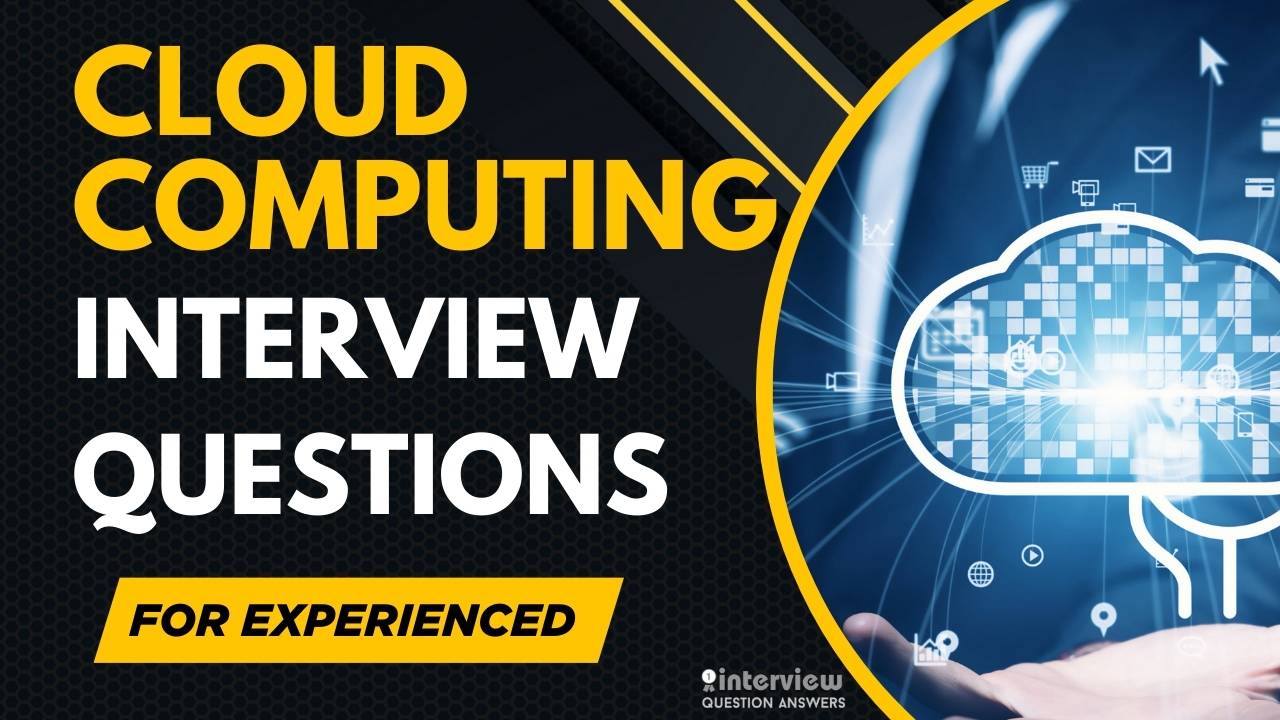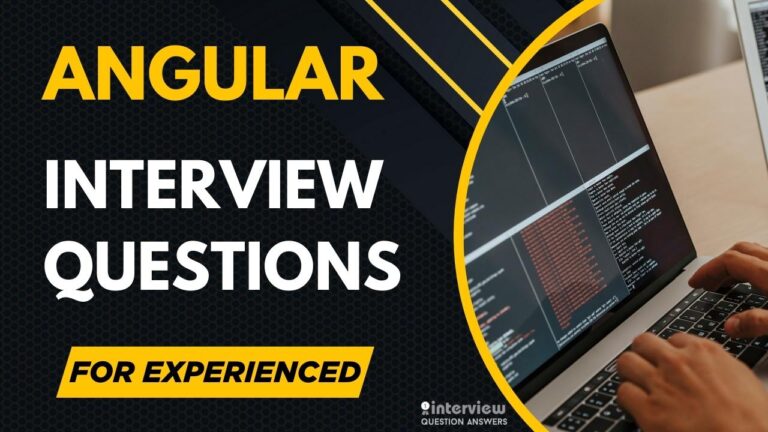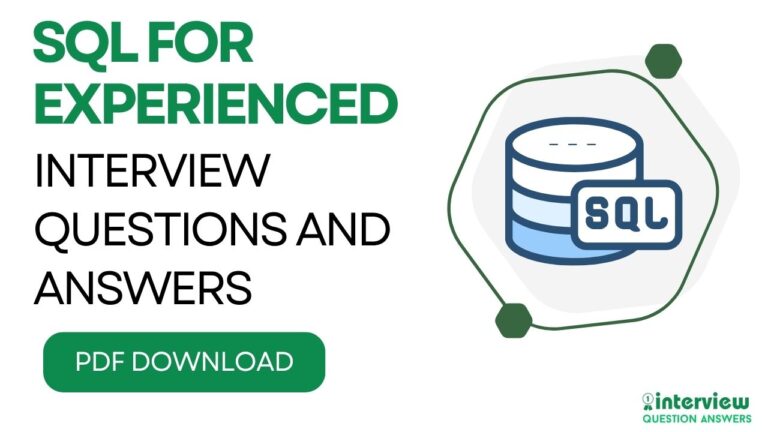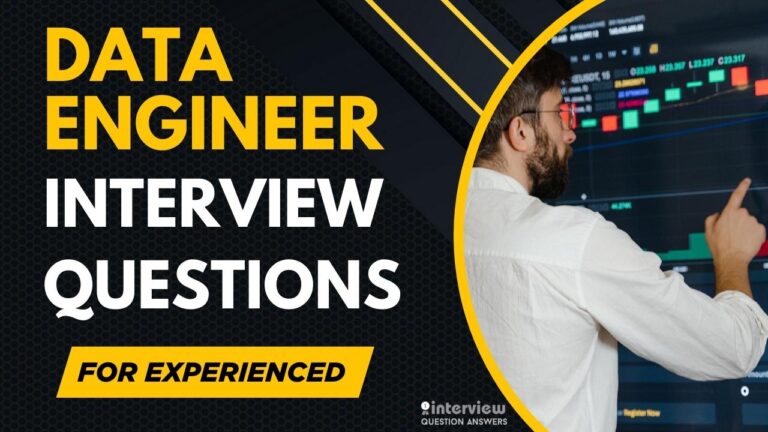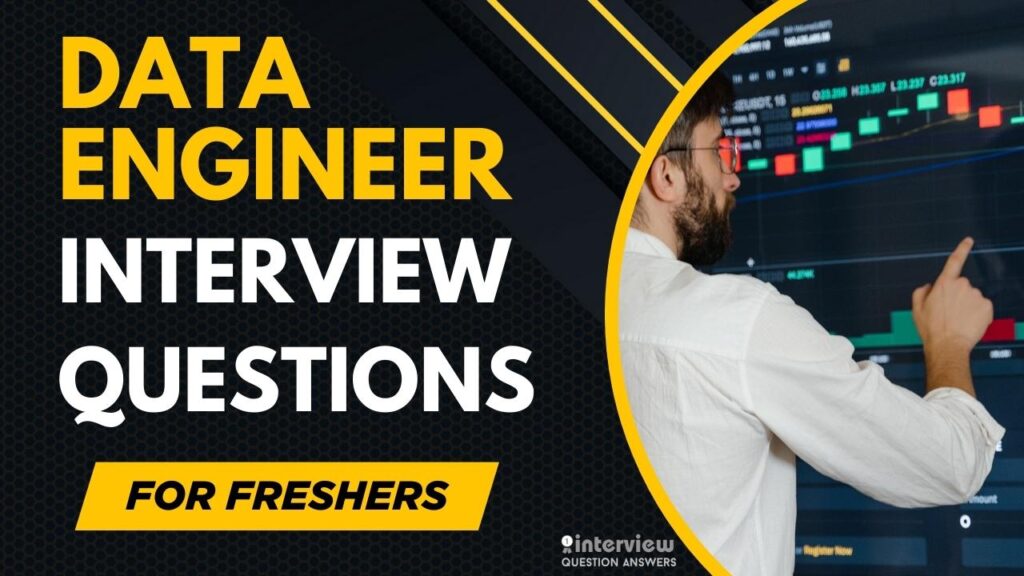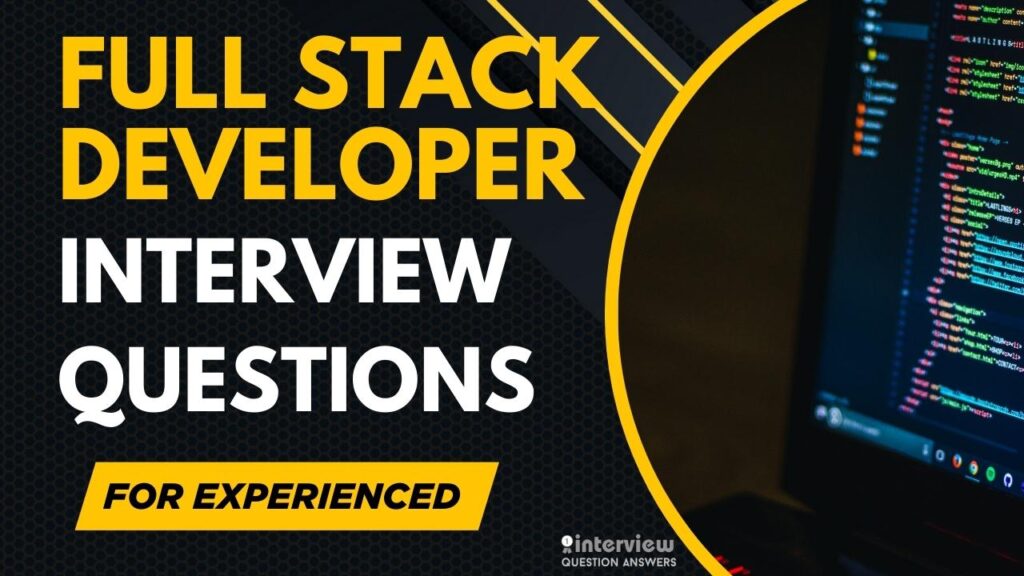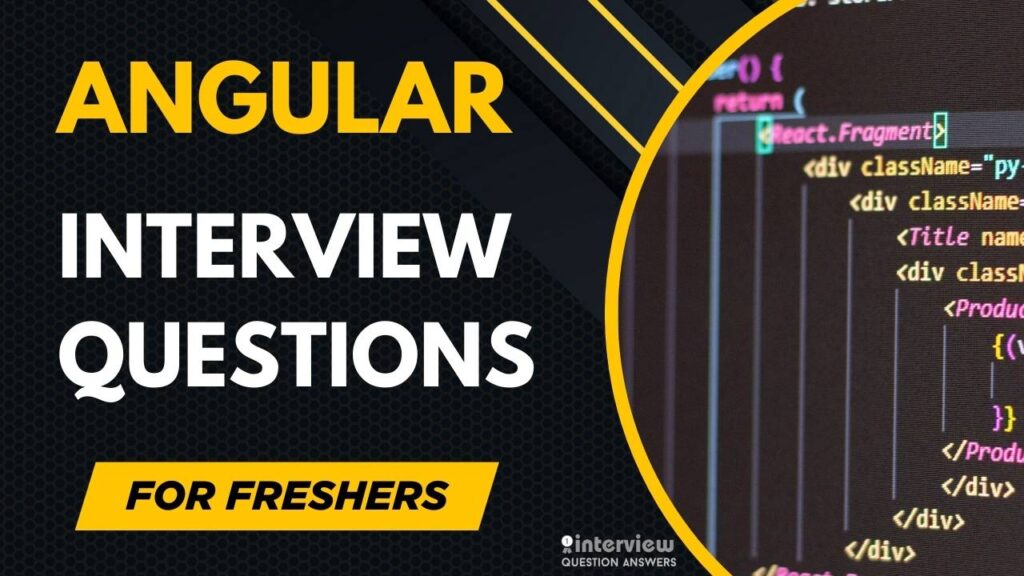Top 50 Cloud Computing Interview Questions for Experienced Professionals
Cloud Computing Interview Questions for Experienced professionals examine advanced cloud architecture knowledge, infrastructure management expertise, and strategic planning abilities that senior specialists must possess. Experienced cloud computing roles demand candidates who understand how to design scalable solutions and lead digital transformation initiatives successfully.
This interview guide includes Cloud Computing Interview Questions for Experienced engineers who have implemented enterprise cloud systems, covering multi-cloud strategies, cost optimization techniques, security compliance frameworks, and team leadership scenarios.
These Cloud Computing Interview Questions for Experienced practitioners will enable you to highlight your technical expertise, demonstrate successful migration projects, and establish your capability to handle complex cloud infrastructure challenges in enterprise environments.
You can also explore: Cloud Computing Interview Questions and Answers PDF
Table of Contents
Cloud Computing Interview Questions for 2 Years Experience
Que 1. What is the difference between scalability and elasticity in cloud computing, and how do you implement them?
Answer:
Scalability is the ability to handle increased workloads by adding resources, while elasticity is the automatic adjustment of resources based on demand. Implement elasticity using AWS Auto Scaling or Azure Scale Sets with policies based on metrics like CPU usage.
# AWS Auto Scaling policy
AutoScalingGroup:
Type: AWS::AutoScaling::AutoScalingGroup
Properties:
MinSize: 1
MaxSize: 5
ScalingPolicies:
- TargetTrackingConfiguration:
TargetValue: 70.0
PredefinedMetricSpecification:
PredefinedMetricType: ASGAverageCPUUtilizationQue 2. How do you secure data in a cloud environment?
Answer:
Use encryption for data at rest (e.g., AWS KMS for S3) and in transit (TLS/HTTPS). Implement IAM policies, network security groups, and regular audits to restrict access and ensure compliance.
{
"Effect": "Allow",
"Action": "s3:GetObject",
"Resource": "arn:aws:s3:::my-bucket/*",
"Principal": {"AWS": "arn:aws:iam::123456789012:user/my-user"}
}Que 3. What is Infrastructure as Code (IaC), and how do you use it?
Answer:
IaC manages infrastructure through code for automation and consistency. Use tools like AWS CloudFormation or Terraform to define resources like EC2 instances or S3 buckets.
# CloudFormation template
Resources:
MyEC2Instance:
Type: AWS::EC2::Instance
Properties:
InstanceType: t2.micro
ImageId: ami-12345678Que 4. How does a Virtual Private Cloud (VPC) enhance cloud security?
Answer:
A VPC isolates resources in a private network, allowing control over subnets, route tables, and security groups. For example, AWS VPC restricts access with network ACLs and security groups.
# AWS VPC configuration
VPC:
Type: AWS::EC2::VPC
Properties:
CidrBlock: 10.0.0.0/16Que 5. How do you implement load balancing in the cloud?
Answer:
Use services like AWS Elastic Load Balancer (ELB) or Azure Load Balancer to distribute traffic across instances, ensuring high availability with health checks.
# AWS ELB configuration
LoadBalancer:
Type: AWS::ElasticLoadBalancingV2::LoadBalancer
Properties:
Subnets: [subnet-1, subnet-2]
Type: applicationQue 6. What is serverless computing, and how do you use it in a project?
Answer:
Serverless computing (e.g., AWS Lambda, Azure Functions) runs code without managing servers, scaling automatically. Use it for event-driven tasks like processing uploads or API endpoints.
// AWS Lambda function
exports.handler = async (event) => {
return { statusCode: 200, body: JSON.stringify('Processed!') };
};Que 7. How do you monitor cloud resources, and what tools do you use?
Answer:
Use tools like AWS CloudWatch, Azure Monitor, or GCP Operations Suite to track metrics (e.g., CPU, memory), set alarms, and analyze logs for performance and issues.
# CloudWatch metric example
aws cloudwatch put-metric-data --metric-name Requests --namespace MyApp --value 100Que 8. What is the role of a content delivery network (CDN) in cloud computing?
Answer:
A CDN (e.g., AWS CloudFront) caches content at edge locations to reduce latency and improve load times for static assets like images and scripts.
# CloudFront distribution
Distribution:
Type: AWS::CloudFront::Distribution
Properties:
DistributionConfig:
Origins:
- DomainName: my-bucket.s3.amazonaws.com
Enabled: trueQue 9. How do you implement a CI/CD pipeline in the cloud?
Answer:
Use tools like AWS CodePipeline, Azure DevOps, or GitHub Actions to automate testing, building, and deployment. Integrate with cloud services like ECS or S3 for delivery.
# GitHub Actions workflow
name: CI
on: [push]
jobs:
build:
runs-on: ubuntu-latest
steps:
- uses: actions/checkout@v3
- run: npm test
- run: aws s3 sync . s3://my-bucketQue 10. What is the difference between containers and virtual machines in the cloud?
Answer:
Containers (e.g., Docker) share the host OS kernel, making them lightweight and fast, while VMs include a full OS, consuming more resources. Containers run on cloud services like AWS ECS, while VMs use EC2.
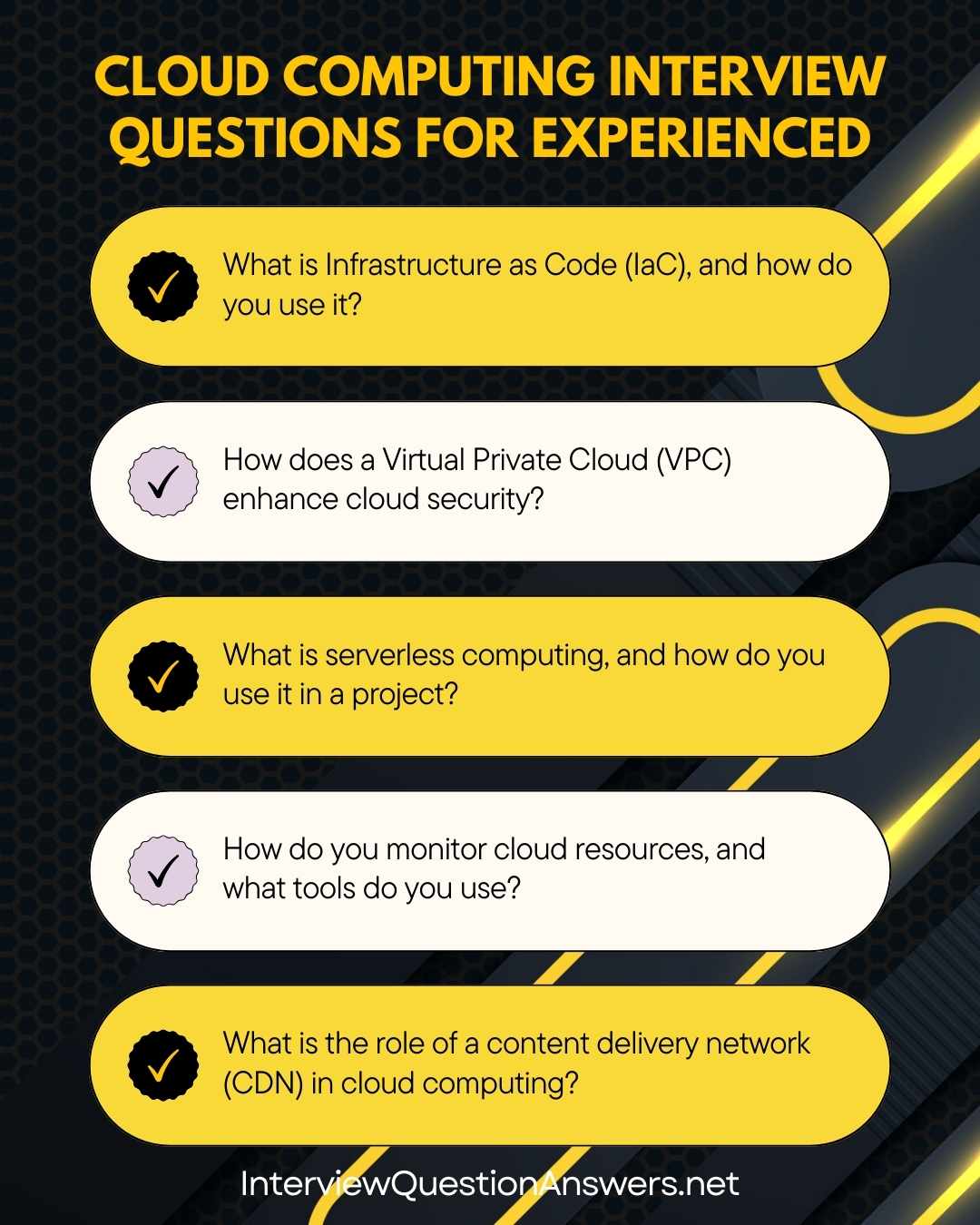
Also Check: Cloud Computing Interview Questions for Freshers
Cloud Computing Interview Questions for 3 Years Experience
Que 11. How do you ensure high availability in a cloud application?
Answer:
Deploy across multiple availability zones, use load balancers, and replicate data with services like AWS RDS Multi-AZ or Azure Cosmos DB for failover and redundancy.
# RDS Multi-AZ
DBInstance:
Type: AWS::RDS::DBInstance
Properties:
MultiAZ: trueQue 12. How do you handle data backup in the cloud?
Answer:
Use services like AWS Backup or Azure Backup to automate data backups. Schedule regular snapshots for databases or storage (e.g., EBS, S3) and store them across regions.
# AWS Backup plan
BackupPlan:
Type: AWS::Backup::BackupPlan
Properties:
BackupPlanName: MyBackup
Rules:
- RuleName: Daily
ScheduleExpression: cron(0 5 * * ? *)Que 13. What is the purpose of IAM roles in cloud security?
Answer:
IAM roles grant temporary access to cloud resources without hardcoding credentials. For example, an EC2 instance role allows access to S3 without API keys.
{
"Effect": "Allow",
"Action": "s3:GetObject",
"Resource": "arn:aws:s3:::my-bucket/*"
}Que 14. How do you optimize costs in a cloud environment?
Answer:
Use cost management tools like AWS Cost Explorer or Azure Cost Management. Right-size instances, use reserved instances, and enable auto-scaling to avoid over-provisioning.
Que 15. How do you implement a cloud-based database, and what are its benefits?
Answer:
Use managed databases like AWS RDS, Azure SQL, or GCP Cloud SQL for scalability and maintenance. Benefits include automated backups, patching, and high availability.
# AWS RDS configuration
DBInstance:
Type: AWS::RDS::DBInstance
Properties:
Engine: mysql
DBInstanceClass: db.t2.microQue 16. What is the role of an API gateway in the cloud?
Answer:
An API gateway (e.g., AWS API Gateway, Azure API Management) manages, secures, and scales APIs, handling authentication, rate limiting, and routing.
# API Gateway configuration
RestApi:
Type: AWS::ApiGateway::RestApi
Properties:
Name: MyApiQue 17. How do you handle disaster recovery in the cloud?
Answer:
Implement multi-region backups, use services like AWS Backup or Azure Site Recovery, and test failover plans. Replicate critical data with tools like S3 Cross-Region Replication.
Que 18. How do you use containers in a cloud environment?
Answer:
Deploy containers with Docker on services like AWS ECS, Azure Container Instances, or GCP Kubernetes Engine for portability and scalability.
# ECS task definition
TaskDefinition:
Type: AWS::ECS::TaskDefinition
Properties:
ContainerDefinitions:
- Name: my-app
Image: my-app:latestQue 19. How do you implement event-driven architecture in the cloud?
Answer:
Use services like AWS EventBridge or Azure Event Grid to trigger actions (e.g., Lambda functions) based on events like file uploads or database changes.
# EventBridge rule
Rule:
Type: AWS::Events::Rule
Properties:
EventPattern:
source: ["aws.s3"]
Targets:
- Arn: !GetAtt MyLambdaFunction.ArnQue 20. How do you monitor and troubleshoot performance issues in a cloud application?
Answer:
Use tools like AWS X-Ray for tracing, CloudWatch for metrics/logs, or Azure Application Insights for performance insights. Analyze latency, errors, and resource usage to identify bottlenecks.
# AWS X-Ray tracing
aws xray put-trace-segments --trace-segment-documents file://trace.jsonCloud Computing Interview Questions for 5 Years Experience
Que 21. How do you design a multi-region cloud architecture for high availability?
Answer:
Deploy resources across multiple regions using services like AWS Route 53 for latency-based routing. Replicate data with S3 Cross-Region Replication or RDS Read Replicas, and use load balancers with health checks to ensure failover. Monitor with CloudWatch for cross-region performance.
# Route 53 latency-based routing
HostedZone:
Type: AWS::Route53::RecordSet
Properties:
Type: A
LatencyRoutingPolicy:
Region: us-east-1
ResourceRecords: [my-app.us-east-1.amazonaws.com]Que 22. How do you implement zero-downtime deployments in a cloud environment?
Answer:
Use blue-green deployments or canary releases with tools like AWS ECS or Kubernetes. Implement rolling updates, feature flags (e.g., LaunchDarkly), and health checks to ensure seamless transitions.
# ECS rolling update
Service:
Type: AWS::ECS::Service
Properties:
DeploymentConfiguration:
MaximumPercent: 200
MinimumHealthyPercent: 100Que 23. How do you secure a cloud-based API against common threats?
Answer:
Use an API gateway (e.g., AWS API Gateway) with JWT/OAuth authentication, rate limiting, and CORS policies. Encrypt traffic with TLS, validate inputs, and monitor with tools like CloudTrail for audit logs.
# API Gateway with JWT
RestApi:
Type: AWS::ApiGateway::RestApi
Properties:
Name: MyApi
EndpointConfiguration:
Types: [REGIONAL]
Authorizers:
- Type: TOKEN
IdentitySource: method.request.header.AuthorizationQue 24. How do you optimize cloud costs for a large-scale application?
Answer:
Use cost management tools (e.g., AWS Cost Explorer, Azure Cost Management) to analyze usage. Optimize with reserved instances, right-sizing resources, auto-scaling, and serverless architectures. Tag resources for cost allocation.
# AWS CLI for cost analysis
aws ce get-cost-and-usage --time-period Start=2025-09-01,End=2025-09-30Que 25. How do you implement an event-driven architecture in the cloud?
Answer:
Use services like AWS EventBridge, Azure Event Grid, or GCP Eventarc to trigger actions (e.g., Lambda functions) based on events like S3 uploads or database changes. Ensure idempotency and error handling.
# EventBridge rule
Rule:
Type: AWS::Events::Rule
Properties:
EventPattern:
source: ["aws.s3"]
detail-type: ["Object Created"]
Targets:
- Arn: !GetAtt MyLambdaFunction.ArnQue 26. How do you manage container orchestration in a cloud environment?
Answer:
Use Kubernetes (e.g., AWS EKS, Azure AKS) or AWS ECS for container orchestration. Configure deployments, services, and auto-scaling with tools like kubectl or ECS CLI for scalability and resilience.
# Kubernetes deployment
apiVersion: apps/v1
kind: Deployment
metadata:
name: my-app
spec:
replicas: 3
template:
spec:
containers:
- name: my-app
image: my-app:latestQue 27. How do you implement monitoring and logging for a cloud application?
Answer:
Use tools like AWS CloudWatch, Azure Monitor, or GCP Operations Suite for metrics, logs, and alerts. Integrate with distributed tracing (e.g., AWS X-Ray) and log aggregators like ELK Stack for debugging.
# CloudWatch log example
aws cloudwatch put-metric-data --metric-name Errors --namespace MyApp --value 5Que 28. How do you handle data migration to the cloud with minimal downtime?
Answer:
Use tools like AWS Database Migration Service (DMS) or Azure Data Factory. Plan schema compatibility, use incremental replication, and validate data post-migration to ensure minimal disruption.
# AWS DMS replication task
ReplicationTask:
Type: AWS::DMS::ReplicationTask
Properties:
SourceEndpointArn: !Ref SourceEndpoint
TargetEndpointArn: !Ref TargetEndpointQue 29. How do you secure a cloud-based database?
Answer:
Enable encryption at rest (e.g., AWS RDS with KMS), use VPC security groups, and restrict access with IAM roles. Implement backups and audit logs with CloudTrail or Azure Monitor.
# RDS with encryption
DBInstance:
Type: AWS::RDS::DBInstance
Properties:
Engine: mysql
StorageEncrypted: trueQue 30. How do you implement a serverless architecture for a complex application?
Answer:
Use AWS Lambda, Azure Functions, or GCP Cloud Functions for compute, paired with serverless databases like Aurora Serverless. Orchestrate workflows with AWS Step Functions and monitor cold starts.
// AWS Lambda with Step Functions
exports.handler = async (event) => {
return { status: 'success', data: event.input };
};Cloud Computing Interview Questions for 7 Years Experience
Que 31. How do you ensure compliance with regulations like GDPR in the cloud?
Answer:
Use encryption, anonymize data, and implement IAM policies. Leverage compliance tools (e.g., AWS Config, Azure Policy) to audit resources and ensure data residency with region-specific deployments.
# AWS Config rule
ConfigRule:
Type: AWS::Config::ConfigRule
Properties:
Source:
Owner: AWS
SourceIdentifier: S3_BUCKET_SERVER_SIDE_ENCRYPTION_ENABLEDQue 32. How do you implement a CI/CD pipeline for cloud-native applications?
Answer:
Use AWS CodePipeline, Azure DevOps, or GitHub Actions to automate testing, building, and deployment to ECS, Lambda, or Kubernetes. Integrate with IaC tools like Terraform for infrastructure updates.
# AWS CodePipeline
Pipeline:
Type: AWS::CodePipeline::Pipeline
Properties:
Stages:
- Name: Build
Actions:
- Name: BuildAction
ActionTypeId:
Category: Build
Provider: CodeBuildQue 33. How do you handle disaster recovery in a cloud environment?
Answer:
Implement multi-region backups with AWS Backup or Azure Site Recovery. Use S3 Cross-Region Replication, test failover plans, and automate recovery with CloudFormation.
# S3 Cross-Region Replication
ReplicationConfiguration:
Rules:
- Destination:
Bucket: arn:aws:s3:::destination-bucket
Status: EnabledQue 34. How do you optimize a cloud-based API for low latency?
Answer:
Use an API gateway with caching (e.g., AWS API Gateway), optimize backend queries, and deploy to edge locations with CloudFront. Monitor latency with CloudWatch or X-Ray.
# API Gateway caching
CacheCluster:
Type: AWS::ApiGateway::Stage
Properties:
CacheClusterEnabled: true
CacheClusterSize: '0.5'Que 35. How do you manage secrets in a cloud application?
Answer:
Use services like AWS Secrets Manager or Azure Key Vault to store and rotate secrets. Access them via IAM roles, avoiding hardcoding credentials.
// AWS Secrets Manager
const AWS = require('aws-sdk');
const secretsManager = new AWS.SecretsManager();
const secret = await secretsManager.getSecretValue({ SecretId: 'my-secret' }).promise();Que 36. How do you implement a microservices architecture in the cloud?
Answer:
Deploy microservices with containers (e.g., AWS ECS, Kubernetes) or serverless functions. Use an API gateway for routing, service discovery with Consul, and monitor with Prometheus.
# ECS service
Service:
Type: AWS::ECS::Service
Properties:
Cluster: MyCluster
TaskDefinition: MyTaskQue 37. How do you handle multi-tenancy in a cloud application?
Answer:
Isolate tenant data with separate schemas, tables, or databases (e.g., AWS RDS). Use IAM policies or VPCs for access control and monitor usage with CloudWatch.
# RDS for multi-tenancy
DBInstance:
Type: AWS::RDS::DBInstance
Properties:
DBName: tenant1
Engine: postgresQue 38. How do you use cloud monitoring tools for proactive issue detection?
Answer:
Use AWS CloudWatch Alarms, Azure Application Insights, or GCP Monitoring to set thresholds for metrics like latency or errors. Integrate with SNS or PagerDuty for alerts.
# CloudWatch Alarm
Alarm:
Type: AWS::CloudWatch::Alarm
Properties:
MetricName: CPUUtilization
Threshold: 80Que 39. How do you implement serverless databases in the cloud?
Answer:
Use serverless databases like AWS Aurora Serverless or Azure Cosmos DB for automatic scaling. Optimize queries and use SDKs for integration.
// Cosmos DB example
const { CosmosClient } = require('@azure/cosmos');
const client = new CosmosClient({ endpoint, key });
const container = client.database('mydb').container('mycontainer');
await container.items.create({ id: '1', name: 'Item' });Que 40. How do you ensure performance optimization in a cloud-native application?
Answer:
Optimize with auto-scaling, caching (e.g., Redis, CloudFront), and efficient database queries. Use profiling tools like AWS X-Ray or Azure Application Insights to identify bottlenecks.
# X-Ray tracing
aws xray put-trace-segments --trace-segment-documents file://trace.jsonCloud Computing Interview Questions for 10 Years Experience
Que 41. How do you architect a globally distributed, fault-tolerant cloud application?
Answer:
Design a multi-region architecture using AWS Route 53 for latency-based routing, replicate data with services like S3 Cross-Region Replication or DynamoDB Global Tables, and deploy containers with Kubernetes (EKS) or ECS for fault tolerance. Implement circuit breakers, health checks, and monitoring with Prometheus/Grafana to ensure resilience.
# Route 53 latency-based routing
HostedZone:
Type: AWS::Route53::RecordSet
Properties:
Type: A
LatencyRoutingPolicy:
Region: us-east-1
ResourceRecords: [my-app.us-east-1.amazonaws.com]Que 42. How do you implement zero-downtime deployments at scale in the cloud?
Answer:
Use blue-green deployments or canary releases with Kubernetes or AWS ECS. Leverage feature flags (e.g., LaunchDarkly), rolling updates, and health checks to minimize disruption. Monitor with CloudWatch and automate rollbacks with CI/CD pipelines like AWS CodePipeline.
# ECS rolling update
Service:
Type: AWS::ECS::Service
Properties:
DeploymentConfiguration:
MaximumPercent: 200
MinimumHealthyPercent: 100Que 43. How do you secure a cloud-native application against advanced threats like DDoS and data breaches?
Answer:
Mitigate DDoS with services like AWS Shield or Cloudflare. Use WAF (Web Application Firewall), encrypt data with KMS, and enforce least privilege with IAM roles. Implement audit logging with CloudTrail and anomaly detection with GuardDuty.
# AWS WAF configuration
WebACL:
Type: AWS::WAFv2::WebACL
Properties:
Scope: REGIONAL
Rules:
- Name: BlockBadBots
Priority: 1
Statement:
ByteMatchStatement:
SearchString: "bad-bot"Que 44. How do you optimize a cloud application for ultra-low latency?
Answer:
Use edge computing with AWS Lambda@Edge or CloudFront Functions, optimize database queries with indexing, and cache responses with Redis or ElastiCache. Deploy to multiple regions and monitor with X-Ray for latency bottlenecks.
// Lambda@Edge function
exports.handler = async (event) => {
const request = event.Records[0].cf.request;
request.headers['x-custom-header'] = [{ key: 'x-custom-header', value: 'value' }];
return request;
};Que 45. How do you implement a serverless microservices architecture in the cloud?
Answer:
Use AWS Lambda or Azure Functions for compute, API Gateway for routing, and DynamoDB or Aurora Serverless for data. Orchestrate workflows with Step Functions and monitor cold starts with CloudWatch. Ensure idempotency and error handling.
# Step Functions state machine
StateMachine:
Type: AWS::StepFunctions::StateMachine
Properties:
DefinitionString: !Sub |
{
"StartAt": "Process",
"States": {
"Process": {
"Type": "Task",
"Resource": "${MyLambdaFunction.Arn}",
"End": true
}
}
}Que 46. How do you ensure compliance with regulations like GDPR or HIPAA in the cloud?
Answer:
Use encryption (AWS KMS, Azure Key Vault), enforce data residency with region-specific deployments, and audit with AWS Config or Azure Policy. Implement data anonymization and access controls with IAM. Regularly test compliance with tools like AWS Trusted Advisor.
# AWS Config compliance rule
ConfigRule:
Type: AWS::Config::ConfigRule
Properties:
Source:
Owner: AWS
SourceIdentifier: RDS_STORAGE_ENCRYPTEDQue 47. How do you design a cost-optimized cloud architecture for a large enterprise?
Answer:
Analyze usage with AWS Cost Explorer or Azure Cost Management, use reserved instances, and implement auto-scaling. Optimize with serverless services, tag resources for cost allocation, and decommission unused resources. Use Trusted Advisor for recommendations.
# AWS CLI cost analysis
aws ce get-cost-and-usage --time-period Start=2025-09-01,End=2025-09-30 --granularity MONTHLYQue 48. How do you implement real-time data processing in a cloud environment?
Answer:
Use streaming services like AWS Kinesis, Azure Event Hubs, or GCP Pub/Sub to process real-time data. Trigger Lambda or Cloud Functions for processing and store results in DynamoDB or BigQuery. Monitor with CloudWatch.
# Kinesis stream
Stream:
Type: AWS::Kinesis::Stream
Properties:
ShardCount: 1Que 49. How do you manage and secure secrets in a distributed cloud application?
Answer:
Use AWS Secrets Manager or Azure Key Vault for secret storage and rotation. Access secrets via IAM roles, integrate with CI/CD pipelines, and audit access with CloudTrail. Avoid hardcoding secrets.
// AWS Secrets Manager
const AWS = require('aws-sdk');
const secretsManager = new AWS.SecretsManager();
const secret = await secretsManager.getSecretValue({ SecretId: 'my-secret' }).promise();Que 50. How do you implement end-to-end observability in a cloud-native application?
Answer:
Use distributed tracing with AWS X-Ray or Azure Application Insights, centralize logs with CloudWatch Logs or ELK Stack, and monitor metrics with Prometheus. Set up dashboards and alerts for proactive issue detection.
# CloudWatch Logs group
LogGroup:
Type: AWS::Logs::LogGroup
Properties:
LogGroupName: MyAppLogsConclusion
The cloud computing field advances continuously with edge computing solutions, AI-driven automation, and hybrid cloud architectures establishing new industry standards for experienced positions. These Cloud Computing Interview Questions for Experienced professionals deliver the strategic preparation required for career advancement, spanning advanced security implementations to enterprise-scale deployments.
Similar Guides:

